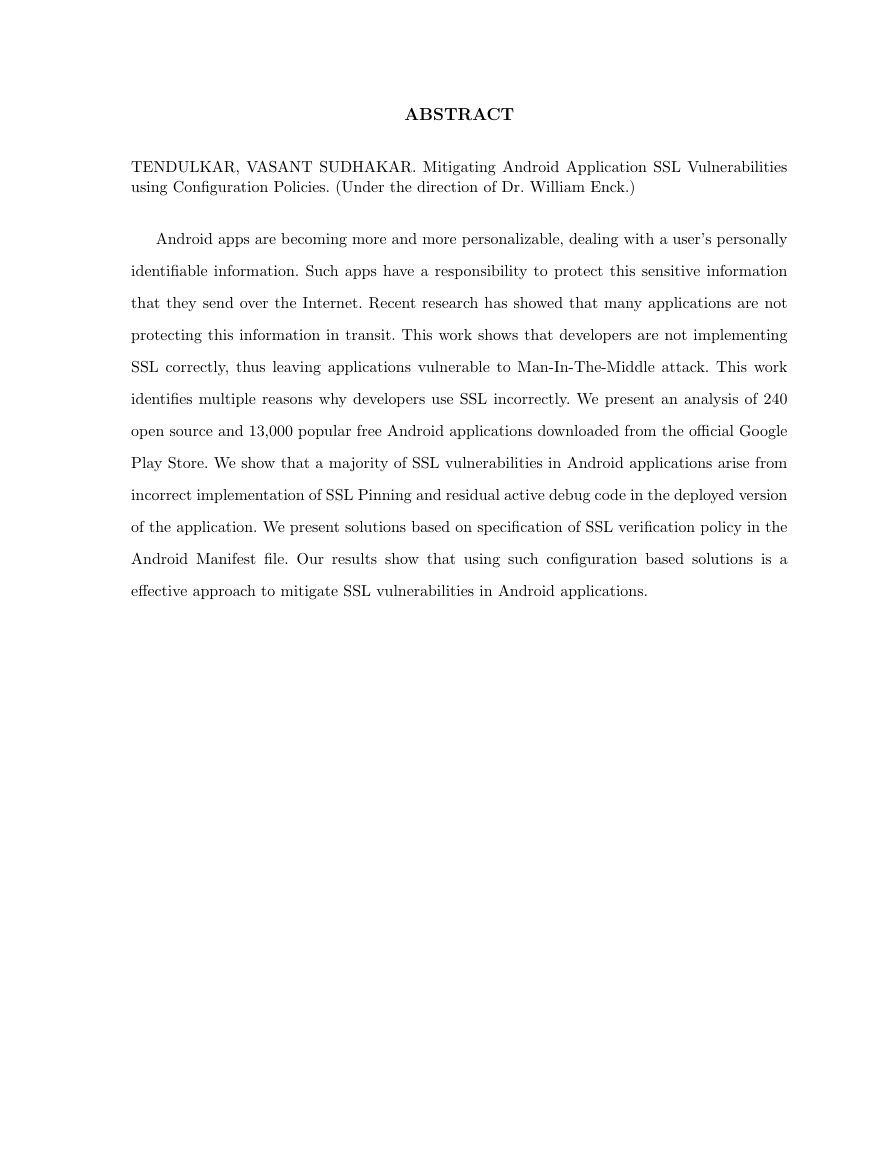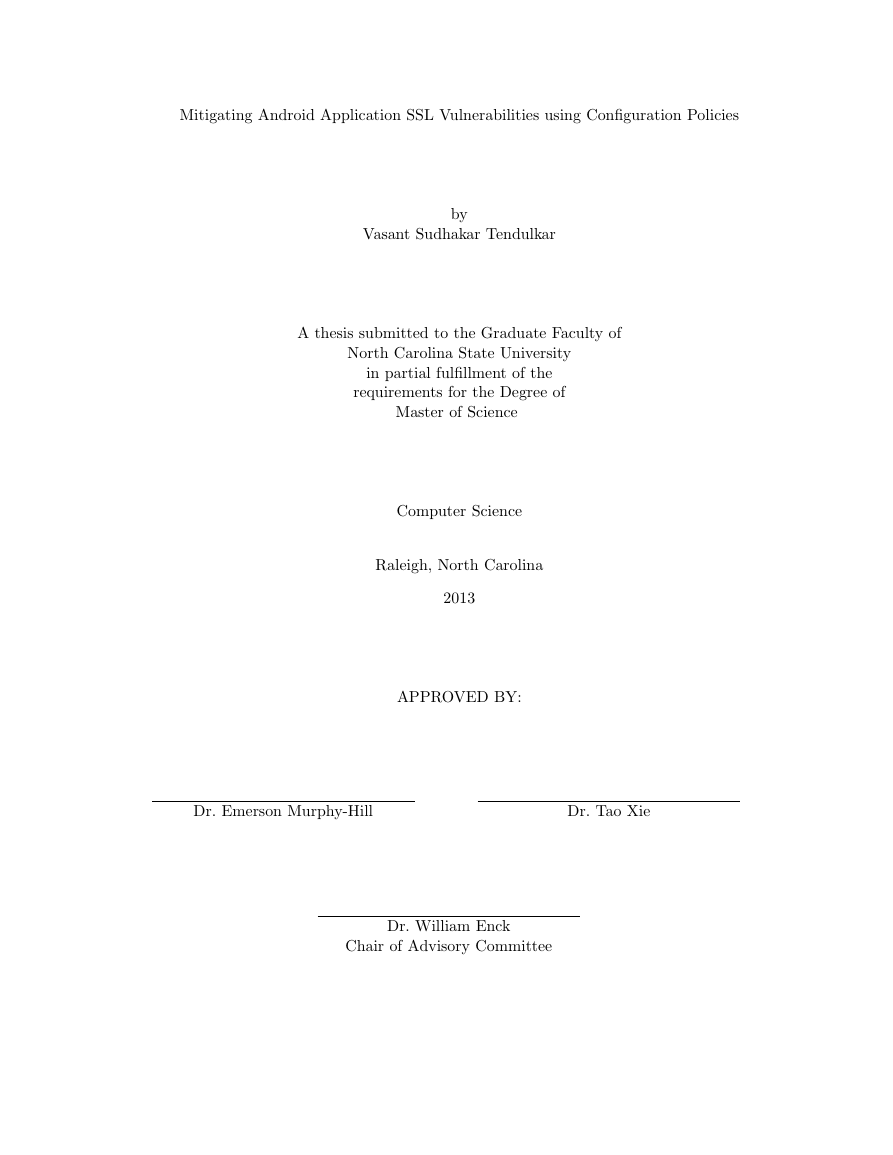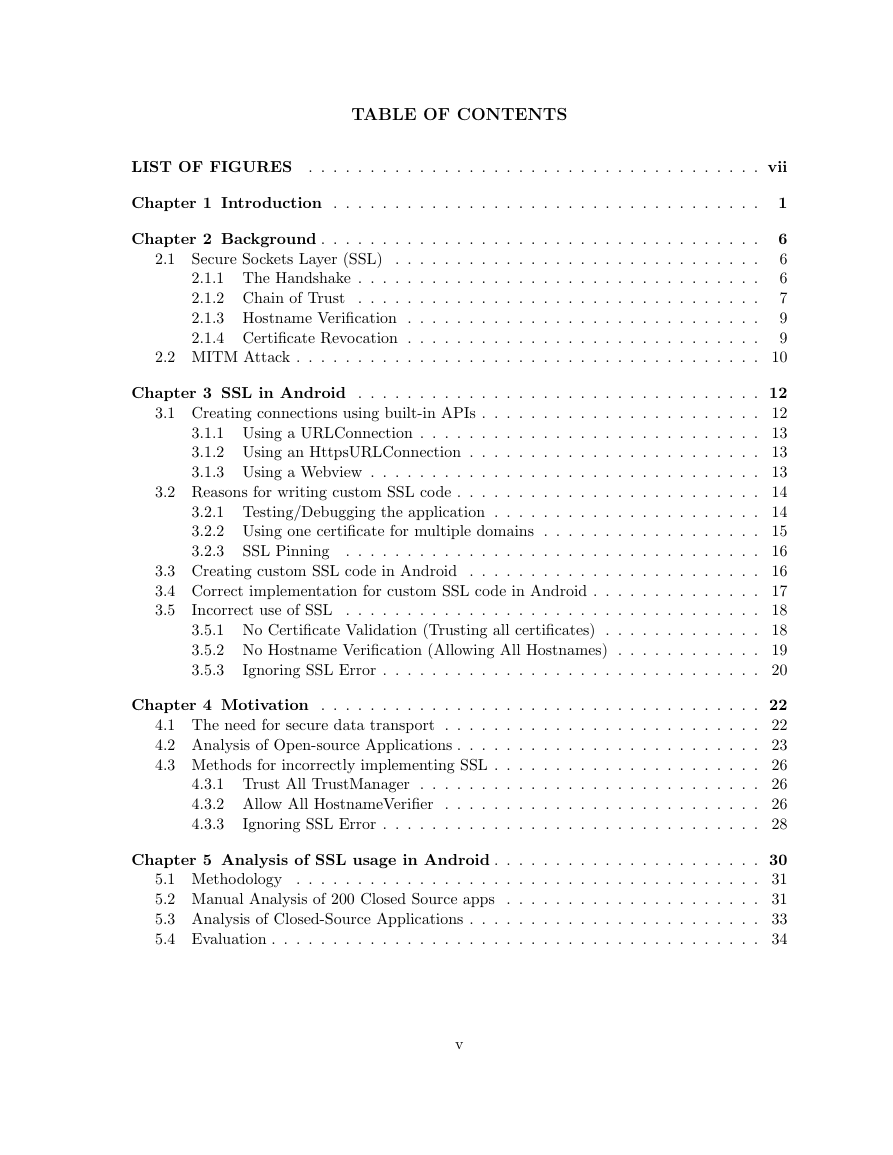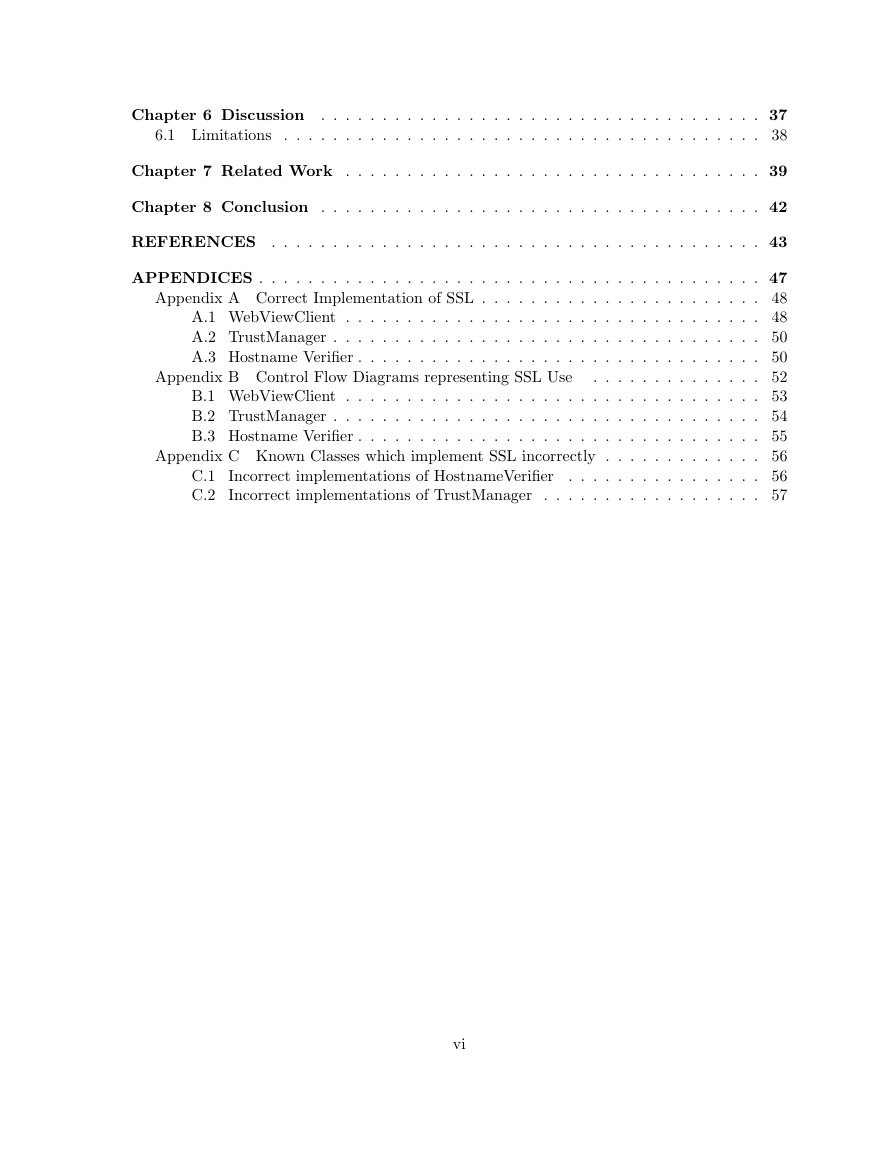ABSTRACT
TENDULKAR, VASANT SUDHAKAR. Mitigating Android Application SSL Vulnerabilities
using Configuration Policies. (Under the direction of Dr. William Enck.)
Android apps are becoming more and more personalizable, dealing with a user’s personally
identifiable information. Such apps have a responsibility to protect this sensitive information
that they send over the Internet. Recent research has showed that many applications are not
protecting this information in transit. This work shows that developers are not implementing
SSL correctly, thus leaving applications vulnerable to Man-In-The-Middle attack. This work
identifies multiple reasons why developers use SSL incorrectly. We present an analysis of 240
open source and 13,000 popular free Android applications downloaded from the official Google
Play Store. We show that a majority of SSL vulnerabilities in Android applications arise from
incorrect implementation of SSL Pinning and residual active debug code in the deployed version
of the application. We present solutions based on specification of SSL verification policy in the
Android Manifest file. Our results show that using such configuration based solutions is a
effective approach to mitigate SSL vulnerabilities in Android applications.
�
© Copyright 2013 by Vasant Sudhakar Tendulkar
All Rights Reserved
�
Mitigating Android Application SSL Vulnerabilities using Configuration Policies
by
Vasant Sudhakar Tendulkar
A thesis submitted to the Graduate Faculty of
North Carolina State University
in partial fulfillment of the
requirements for the Degree of
Master of Science
Computer Science
Raleigh, North Carolina
2013
APPROVED BY:
Dr. Emerson Murphy-Hill
Dr. Tao Xie
Dr. William Enck
Chair of Advisory Committee
�
DEDICATION
To my Aai, Baba, Sameer, Niharika ... And to NC State for the opportunity.
ii
�
BIOGRAPHY
The author completed his Bachelors Degree in Computer Engineering from St. Francis Institute
of Technology, University of Mumbai, India and joined NC State University as a Master’s
student (MR-CS) in Fall 2011.
iii
�
ACKNOWLEDGEMENTS
First and foremost I express my gratitude to my advisor, Dr. William Enck for his guidance
and support. I consider myself fortunate to have the opportunity to work and learn under his
guidance. I am thankful for his positive outlook and constant encouragement that has helped
me throughout this endeavor. This thesis would not have been possible without his help and
guidance. I also thank Dr. Emerson Murphy-Hill and Dr. Tao Xie for taking the time to be on
my committee and for being supportive of my research. I thank Ashwin Shashidharan, Adwait
Nadkarni, Anson Ho and Sigmund Gorski for their valuable inputs on this work. I also thank
Meghambari, Kunal, Vinay and Arya for their support.
Finally, I thank my family for their support. I am grateful to my parents Sudhakar and
Smita Tendulkar for their hard work, sacrifices and commitment to family and education that
have provided me with the opportunity to pursue my dreams and made this journey possible.
I also thank my brother Sameer Tendulkar for his tremendous patience, help and support.
iv
�
TABLE OF CONTENTS
LIST OF FIGURES . . . . . . . . . . . . . . . . . . . . . . . . . . . . . . . . . . . . . vii
Chapter 1 Introduction . . . . . . . . . . . . . . . . . . . . . . . . . . . . . . . . . . .
1
Chapter 2 Background . . . . . . . . . . . . . . . . . . . . . . . . . . . . . . . . . . . .
2.1 Secure Sockets Layer (SSL) . . . . . . . . . . . . . . . . . . . . . . . . . . . . . .
2.1.1 The Handshake . . . . . . . . . . . . . . . . . . . . . . . . . . . . . . . . .
2.1.2 Chain of Trust
. . . . . . . . . . . . . . . . . . . . . . . . . . . . . . . . .
2.1.3 Hostname Verification . . . . . . . . . . . . . . . . . . . . . . . . . . . . .
2.1.4 Certificate Revocation . . . . . . . . . . . . . . . . . . . . . . . . . . . . .
6
6
6
7
9
9
2.2 MITM Attack . . . . . . . . . . . . . . . . . . . . . . . . . . . . . . . . . . . . . . 10
Chapter 3 SSL in Android . . . . . . . . . . . . . . . . . . . . . . . . . . . . . . . . . 12
3.1 Creating connections using built-in APIs . . . . . . . . . . . . . . . . . . . . . . . 12
3.1.1 Using a URLConnection . . . . . . . . . . . . . . . . . . . . . . . . . . . . 13
3.1.2 Using an HttpsURLConnection . . . . . . . . . . . . . . . . . . . . . . . . 13
3.1.3 Using a Webview . . . . . . . . . . . . . . . . . . . . . . . . . . . . . . . . 13
3.2 Reasons for writing custom SSL code . . . . . . . . . . . . . . . . . . . . . . . . . 14
3.2.1 Testing/Debugging the application . . . . . . . . . . . . . . . . . . . . . . 14
3.2.2 Using one certificate for multiple domains . . . . . . . . . . . . . . . . . . 15
3.2.3
SSL Pinning . . . . . . . . . . . . . . . . . . . . . . . . . . . . . . . . . . 16
3.3 Creating custom SSL code in Android . . . . . . . . . . . . . . . . . . . . . . . . 16
3.4 Correct implementation for custom SSL code in Android . . . . . . . . . . . . . . 17
Incorrect use of SSL . . . . . . . . . . . . . . . . . . . . . . . . . . . . . . . . . . 18
3.5
3.5.1 No Certificate Validation (Trusting all certificates) . . . . . . . . . . . . . 18
3.5.2 No Hostname Verification (Allowing All Hostnames) . . . . . . . . . . . . 19
3.5.3
Ignoring SSL Error . . . . . . . . . . . . . . . . . . . . . . . . . . . . . . . 20
Chapter 4 Motivation . . . . . . . . . . . . . . . . . . . . . . . . . . . . . . . . . . . . 22
4.1 The need for secure data transport . . . . . . . . . . . . . . . . . . . . . . . . . . 22
4.2 Analysis of Open-source Applications . . . . . . . . . . . . . . . . . . . . . . . . . 23
4.3 Methods for incorrectly implementing SSL . . . . . . . . . . . . . . . . . . . . . . 26
4.3.1 Trust All TrustManager . . . . . . . . . . . . . . . . . . . . . . . . . . . . 26
4.3.2 Allow All HostnameVerifier . . . . . . . . . . . . . . . . . . . . . . . . . . 26
4.3.3
Ignoring SSL Error . . . . . . . . . . . . . . . . . . . . . . . . . . . . . . . 28
Chapter 5 Analysis of SSL usage in Android . . . . . . . . . . . . . . . . . . . . . . 30
5.1 Methodology . . . . . . . . . . . . . . . . . . . . . . . . . . . . . . . . . . . . . . 31
5.2 Manual Analysis of 200 Closed Source apps . . . . . . . . . . . . . . . . . . . . . 31
5.3 Analysis of Closed-Source Applications . . . . . . . . . . . . . . . . . . . . . . . . 33
5.4 Evaluation . . . . . . . . . . . . . . . . . . . . . . . . . . . . . . . . . . . . . . . . 34
v
�
Chapter 6 Discussion . . . . . . . . . . . . . . . . . . . . . . . . . . . . . . . . . . . . 37
6.1 Limitations . . . . . . . . . . . . . . . . . . . . . . . . . . . . . . . . . . . . . . . 38
Chapter 7 Related Work . . . . . . . . . . . . . . . . . . . . . . . . . . . . . . . . . . 39
Chapter 8 Conclusion . . . . . . . . . . . . . . . . . . . . . . . . . . . . . . . . . . . . 42
REFERENCES . . . . . . . . . . . . . . . . . . . . . . . . . . . . . . . . . . . . . . . . 43
Appendix B Control Flow Diagrams representing SSL Use
APPENDICES . . . . . . . . . . . . . . . . . . . . . . . . . . . . . . . . . . . . . . . . . 47
Appendix A Correct Implementation of SSL . . . . . . . . . . . . . . . . . . . . . . . 48
A.1 WebViewClient . . . . . . . . . . . . . . . . . . . . . . . . . . . . . . . . . . 48
A.2 TrustManager . . . . . . . . . . . . . . . . . . . . . . . . . . . . . . . . . . . 50
A.3 Hostname Verifier . . . . . . . . . . . . . . . . . . . . . . . . . . . . . . . . . 50
. . . . . . . . . . . . . . 52
B.1 WebViewClient . . . . . . . . . . . . . . . . . . . . . . . . . . . . . . . . . . 53
B.2 TrustManager . . . . . . . . . . . . . . . . . . . . . . . . . . . . . . . . . . . 54
B.3 Hostname Verifier . . . . . . . . . . . . . . . . . . . . . . . . . . . . . . . . . 55
Appendix C Known Classes which implement SSL incorrectly . . . . . . . . . . . . . 56
. . . . . . . . . . . . . . . . 56
C.1 Incorrect implementations of HostnameVerifier
C.2 Incorrect implementations of TrustManager . . . . . . . . . . . . . . . . . . 57
vi
�
















 2023年江西萍乡中考道德与法治真题及答案.doc
2023年江西萍乡中考道德与法治真题及答案.doc 2012年重庆南川中考生物真题及答案.doc
2012年重庆南川中考生物真题及答案.doc 2013年江西师范大学地理学综合及文艺理论基础考研真题.doc
2013年江西师范大学地理学综合及文艺理论基础考研真题.doc 2020年四川甘孜小升初语文真题及答案I卷.doc
2020年四川甘孜小升初语文真题及答案I卷.doc 2020年注册岩土工程师专业基础考试真题及答案.doc
2020年注册岩土工程师专业基础考试真题及答案.doc 2023-2024学年福建省厦门市九年级上学期数学月考试题及答案.doc
2023-2024学年福建省厦门市九年级上学期数学月考试题及答案.doc 2021-2022学年辽宁省沈阳市大东区九年级上学期语文期末试题及答案.doc
2021-2022学年辽宁省沈阳市大东区九年级上学期语文期末试题及答案.doc 2022-2023学年北京东城区初三第一学期物理期末试卷及答案.doc
2022-2023学年北京东城区初三第一学期物理期末试卷及答案.doc 2018上半年江西教师资格初中地理学科知识与教学能力真题及答案.doc
2018上半年江西教师资格初中地理学科知识与教学能力真题及答案.doc 2012年河北国家公务员申论考试真题及答案-省级.doc
2012年河北国家公务员申论考试真题及答案-省级.doc 2020-2021学年江苏省扬州市江都区邵樊片九年级上学期数学第一次质量检测试题及答案.doc
2020-2021学年江苏省扬州市江都区邵樊片九年级上学期数学第一次质量检测试题及答案.doc 2022下半年黑龙江教师资格证中学综合素质真题及答案.doc
2022下半年黑龙江教师资格证中学综合素质真题及答案.doc